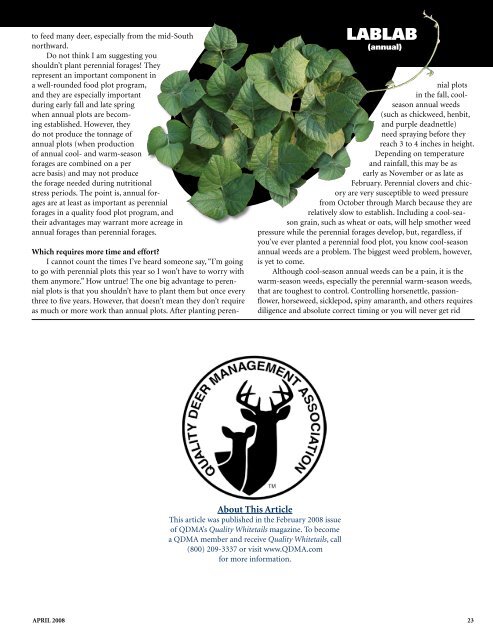Create successful ePaper yourself
Turn your PDF publications into a flip-book with our unique Google optimized e-Paper software.
to feed many deer, especially from the mid-South<br />
northward.<br />
Do not think I am suggesting you<br />
shouldn’t plant perennial forages! They<br />
represent an important component in<br />
a well-rounded food plot program,<br />
and they are especially important<br />
during early fall and late spring<br />
when annual plots are becoming<br />
established. However, they<br />
do not produce the tonnage of<br />
annual plots (when production<br />
of annual cool- and warm-season<br />
forages are combined on a per<br />
acre basis) and may not produce<br />
the forage needed during nutritional<br />
stress periods. The point is, annual forages<br />
are at least as important as perennial<br />
forages in a quality food plot program, and<br />
their advantages may warrant more acreage in<br />
annual forages than perennial forages.<br />
lablab<br />
(annual)<br />
Which requires more time and effort?<br />
I cannot count the times I’ve heard someone say, “I’m going<br />
to go with perennial plots this year so I won’t have to worry with<br />
them anymore.” How untrue! The one big advantage to perennial<br />
plots is that you shouldn’t have to plant them but once every<br />
three to five years. However, that doesn’t mean they don’t require<br />
as much or more work than annual plots. After planting perennial<br />
plots<br />
in the fall, coolseason<br />
annual weeds<br />
(such as chickweed, henbit,<br />
and purple deadnettle)<br />
need spraying before they<br />
reach 3 to 4 inches in height.<br />
Depending on temperature<br />
and rainfall, this may be as<br />
early as November or as late as<br />
February. Perennial clovers and chicory<br />
are very susceptible to weed pressure<br />
from October through March because they are<br />
relatively slow to establish. Including a cool-season<br />
grain, such as wheat or oats, will help smother weed<br />
pressure while the perennial forages develop, but, regardless, if<br />
you’ve ever planted a perennial food plot, you know cool-season<br />
annual weeds are a problem. The biggest weed problem, however,<br />
is yet to come.<br />
Although cool-season annual weeds can be a pain, it is the<br />
warm-season weeds, especially the perennial warm-season weeds,<br />
that are toughest to control. Controlling horsenettle, passionflower,<br />
horseweed, sicklepod, spiny amaranth, and others requires<br />
diligence and absolute correct timing or you will never get rid<br />
About This Article<br />
This article was published in the February 2008 issue<br />
of QDMA’s Quality Whitetails magazine. To become<br />
a QDMA member and receive Quality Whitetails, call<br />
(800) 209-3337 or visit www.QDMA.com<br />
for more information.<br />
APRIL 2008 23




